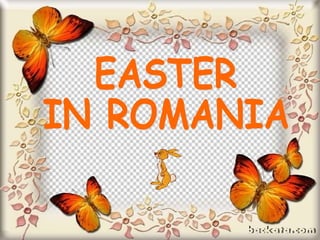
Legendaiepurasuluidepasti
- 1. EASTER IN ROMANIA
- 2. Easter is a Christian holiday. It celebrates the Resurrection , or return to life, of Jesus Christ. Easter is celebrated on the Sunday after the fourth full moon following Christmas, which is also the first full moon after the vernal equinox. Easter is the end of a season in the church called Lent . Lent is the season after Carnival . During Lent, it is a tradition to give up eating meat and other animal fats. The word carnival comes from this tradition (romanian carne = meat). Mardi Gras means “Fat Tuesday” and is the last day of Carnival.
- 3. Although not many people today give up all meat and animal products, people do Often try to give up a vice , or bad habit, for Lent. They might try to be kinder to strangers, or stop biting their nails. Lent lasts forty days (the Sundays of Lent are not counted). The Sunday before Easter is Palm Sunday . According to the Gospels , the books of the Bible that tell the story of Christ and his teaching, Jesus Christ went to Jerusalem on Palm Sunday.
- 4. ROMANIAN EASTER CELEBRATIONS Flowers Saturday (Lazarus’ Saturday) Palm Day (Flowers Day) Great Thursday Great Friday Easter The Small Fountain Good People’s Easter
- 5. The Easter is the most important celebration of the Romanian people and it is preceded by numerous preparations and rituals. It’s a must for the people to have a clean house and have all the ritual foods ready. This is why the cleaning starts on Great Thursday. Men, who are usually working in the field or at the forest, will remain home starting with this day and will take out the thrash, fix the fence, cut wood, bring water, butcher the lambs. Women are the ones that paint and decorate the eggs, do the laundry and generally clean the house. Because it’s a good thing to have a new piece of clothing on the Easter, girls and young wives start to sew shirts for them and also for their parents, brothers, husbands or children, with about two weeks in advance.
- 6. Traditional Easter food The eggs are painted starting with Thursday. Initially the only accepted color was red, but in time other colors were also applied – yellow, green, blue and even black. In the villages the paint is still obtained from plants.
- 7. The most interesting traditional eggs are the decorated eggs (in Romanian they are called “oua incondeiate”, “oua impiestrite”, “ oua inchiestrite”). Special instruments are used for decorating them. These take the form of very thin and round sticks and are called “ chisita (bijara)”,“matuf (motoc)” or “festeleu”. The “festeleu” is a sharp stick made of beech wood. At one end it has linen or cotton little pieces. The “festeleu” is soaked in melted wax. In contact with the surface of the egg, little dots will appear.
- 8. The “pasca” can be simple, with jagged margins, or it can have dough braids. The middle braid is cross-shaped, reminding of Jesus’ crucifixion. This is called a “cross pasca”. The simple “pasca” is for the family, while the “cross pasca” is taken to the church, in order to be sanctified. Small “pasca” (“pascute”) are baked for the little children. ” Pasca”, a special Easter cake, is baked on Great Thursday, but especially on Saturday, so it wouldn’t alter until Easter. It has a round shape (reminding little Jesus’ diapers) or a rectangular one (the shape of His grave). In some regions “pasca” is also baked on St. George Day.
- 9. Saturday night, when all the cleaning and preparations in the house are done,the steak, the pies and the cakes are put on the table, in the “clean room”. After they clean and dress the new clothes, the people take a bowl with “pasca”, eggs and steak and go to the church, where the aliments will be sanctified. Only the ill old men and little children remain at home, as it is said that who can go to the church on Easter night, but he doesn’t do it, will get ill. OUR SALUTATIONS ARE “ Hristos a î nviat!" - Christ is risen! “ Adev ă rat a î nviat!“ True is risen!
- 11. THE ROMANIAN TEAM WISH YOU A HAPPY EASTER AND ALL THE BEST!
